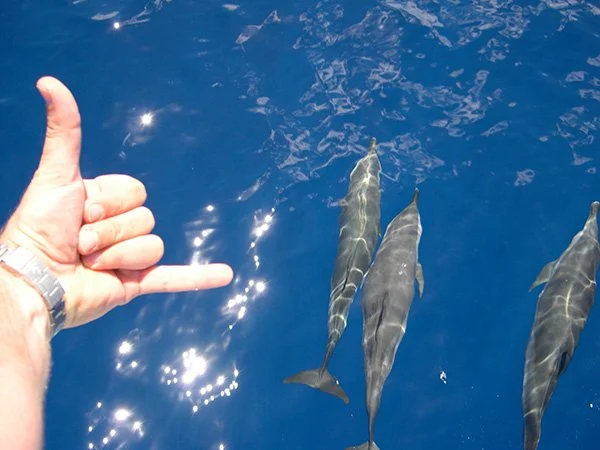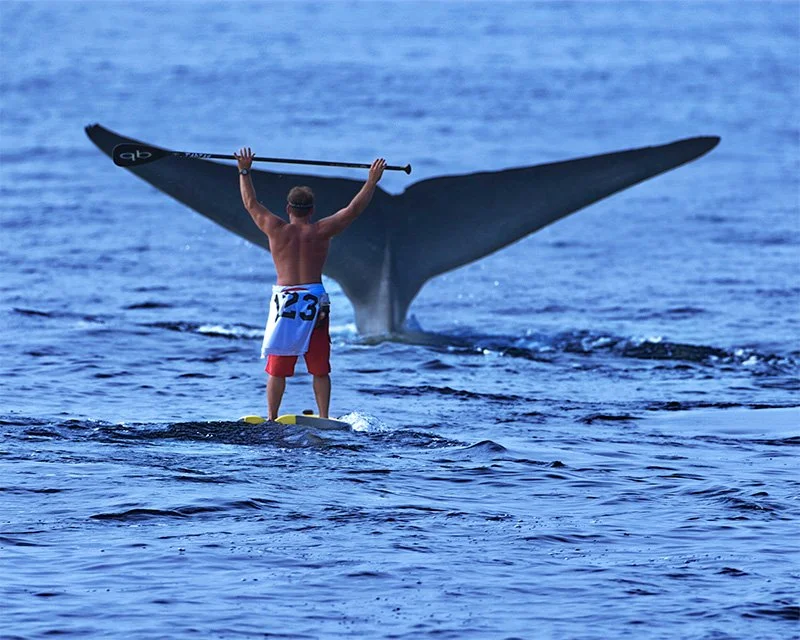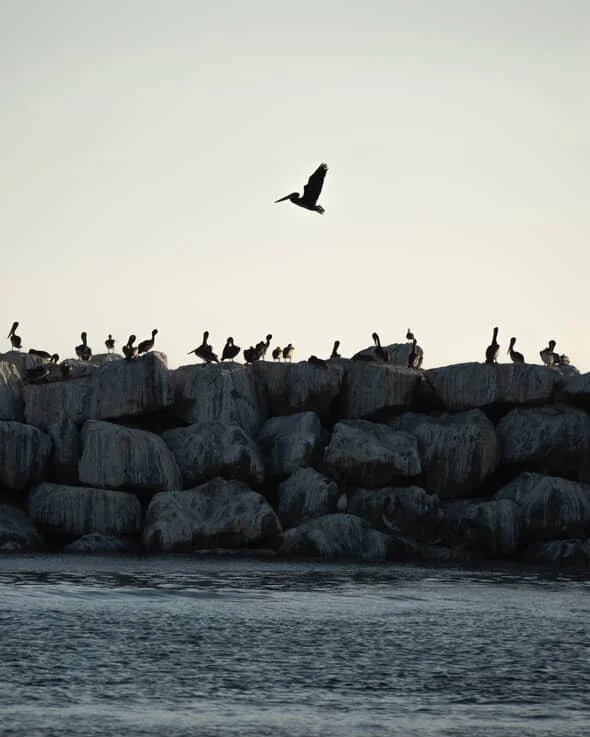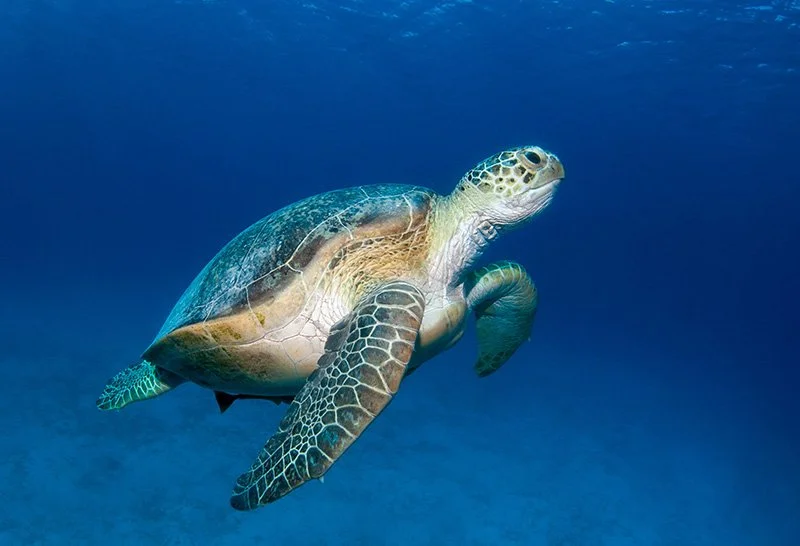Pro SUP Guide to Safe, Respectful & Legal Wildlife Interactions
For Paddleboarders & Kayakers in Marina del Rey
To paddle through Marina del Rey is to slip into the hushed space shared with creatures that do not owe us their attention, much less their trust. And yet, sometimes they offer it none the less: a sea lion surfacing beside your kayak with a knowing blink, a cormorant slicing silently in front of your board, a leopard shark curving its way across the flats. These moments are rare because the conditions must be right — and the human must be a quiet and mindful overserver.
Marine mammals — sea lions, seals, dolphins — are federally protected as are nesting birds and rookeries that dot the tree canopy and riprap. It’s illegal to harass, touch, or feed marine mammals under the Marine Mammal Protection Act, but their body language will tell you all you need to know.
If a heron lifts its wings, it’s thinking about fleeing. If a sea lion watches you approach without returning to sleep, it’s assessing risk. If a snowy egret turns its back, it’s already decided to leave. The kindest thing you can do in these moments is to pause, let your board or kayak drift and lower your paddle to give them the stillness needed for them to feel safe.
Feeding these animals is a violation of the law and disrupts the natural rhythm of the marina’s ecosystem. A gull that learns to expect snacks from a paddleboard can become a nuisance and a sea lion that expects baitfish from a dock may become aggressive. It’s illegal to harass, touch, or feed marine mammals under the Marine Mammal Protection Act.
Be mindful of your noise level. Music, conversation or the click of a shutter can echo across the marina, breaking the stillness required for encounters to happen. Especially in the inner marina, near nests and haul-out zones, the best approach is quiet curiosity. You’re not invisible but you can be unobtrusive.
Movement matters. A hard paddle stroke toward a basking animal may send an unintended message. Drift when you can. Let them lead the encounter. You might be surprised how comfortable and curious a wild animal will come when you stop trying to close the distance.
Stay out of the center of the channel. Keep right in basins. Stay in the “paddle lanes” of the main channel.
California Sea Lion
Photo Credit: Brandon Kirk
California Sea Lion (Zalophus californianus)
Sighting Likelihood: Very Common
Charismatic, loud, and unmistakable, California sea lions are highly social marine mammals known for their agility both in water and on docks. They play a key role in local food webs, preying on fish and interacting closely with harbor infrastructure.
Unique Behaviors: Bark constantly, haul out in large groups, and “porpoise” through the water. Males compete for space on docks and floats, often loudly jostling each other.
Pacific Harbor Seal
Photo Credit: Kirill Umrikhin
Pacific Harbor Seal (Phoca vitulina richardii)
Sighting Likelihood: Occasional
Quieter and more solitary than sea lions, harbor seals are shy pinnipeds with spotted coats and large, soulful eyes. They are important indicators of coastal habitat health.
Unique Behaviors: Haul out individually or in small groups; don’t bark but may snort or sigh. Often rest motionless on rocks or docks and slip away silently when disturbed.
Coastal Bottlenose Dolphins
Photo Credit: Mike Vaughan Jr.
Coastal Bottlenose Dolphin (Tursiops truncatus)
Sighting Likelihood: Rare (inside harbor); Common (just outside breakwall)
Highly intelligent and social, bottlenose dolphins cruise the coastline and occasionally enter harbors chasing fish. They are among the most emotionally engaging marine mammals for paddlers to encounter.
Unique Behaviors: Surface and breathe with a characteristic blow, travel in small pods, and may exhibit curiosity toward kayaks or boards.
You may also see: Pacific White-sided Dolphin (Extemely rare), stray whale near harbor mouth (Near mythic)
Grey Whale
Gray whales are large baleen whales known for their long migrations and barnacle-studded skin. Every year, they travel more than 10,000 miles round trip between the cold feeding grounds of the Arctic and the warm calving lagoons of Baja California — passing just offshore of Marina del Rey in the process.
Unique Behaviors: Breaches, spyhops, and fluke dives are common during migration. Feeds by turning on its side to scoop sediment filtering crustaceans through baleen plates. Often seen traveling in pairs or small groups during the journey
Brown Pelicans
A coastal icon with a prehistoric silhouette, the brown pelican is famous for its headfirst plunge-dives and oversized throat pouch. It plays a key role in balancing small fish populations and is a frequent visual companion on paddles through the harbor.
Unique Behaviors: Soars low in V-formation over water, then dives from height to catch fish. Often rests in groups on buoys, docks, and poles, and may be seen draining its pouch in a dramatic throat stretch.
Great Blue Heron
Tall, solitary, and statuesque, the great blue heron is the largest heron in North America. It anchors the marina’s shorebird hierarchy and signals healthy shallow-water habitats.
Unique Behaviors: Stands motionless while hunting, then strikes with lightning speed. Croaks loudly in flight. Builds large stick nests high in marina trees.
Snowy Egret
The sleek snowy egrets are known for flashy hunting techniques. It adds elegant motion and brightness to our shallows.
Unique Behaviors: Taps and stirs the sand with its feet to flush prey. Moves with quick jabs and sudden stops. Emits sharp chirps when startled.
Elegant Tern
With its long orange bill and tousled black crest, the elegant tern is a slender coastal flyer and a summer hallmark of Pacific harbors. It often travels in noisy flocks, its sharp calls carrying across the water.
Unique Behaviors: Skims in loose formation just above the surface. Hovers briefly, then makes quick, shallow plunge-dives to snatch small schooling fish.
Double-crested Cormorant
Photo Credit: Jeff Huth
Double Crested Cormorant (Nannopterum auritum)
Sighting Likelihood: Very Common
The double-crested cormorant is a sleek, black seabird with a long neck and piercing turquoise eyes. Often mistaken for a duck at a distance, it is a skilled underwater hunter that uses its entire body as a spear.
Unique Behaviors: Dives and swims underwater to chase fish. Rests with wings spread wide to dry — a signature posture. Nests in colonies on cliffs or man-made structures.
Round Stingray
Photo Credit: The Ocean Agency
Round Stingray (Urobatis halleri)
Sighting Likelihood: Very Common (Summer)
Small and disc-shaped, the round stingray is one of the most frequently encountered creatures in the Mother’s Beach shallows. Although shy and gentle, it has a venomous tail spine that can sting if stepped on.
Unique Behaviors: Lies buried in sand with only eyes visible; may suddenly flap away, stirring up a puff of sediment.
Leopard Sharks
Photo Credit: Seth Mitchell
Leopard Shark (Triakis semifasciata)
Sighting Likelihood: Seasonally Common
Graceful and beautifully patterned, leopard sharks are small, harmless sharks that cruise the shallow, sandy bottoms of the harbor. They help maintain ecological balance by feeding on crabs, clams, and small fish.
Unique Behaviors: Often seen swimming slowly in loose schools, zigzagging near the seafloor. Their striking dark saddle spots are visible from above in clear water.
California’s state marine fish, the garibaldi is a vivid orange reef-dweller that brings color to the underwater scene. Though more common in rocky kelp habitats, individuals are sometimes seen near the jetty.
Unique Behaviors:
Territorial and bold, garibaldi may inspect paddlers or boats passing overhead. Males tend gardens of red algae and defend their nests aggressively.
California Halibut
Photo Credit: Shane Anderson
California Halibut (Paralichthys californicus)
Sighting Likelihood: Occasional
A camouflaged ambush predator, the halibut lies flat on the seafloor waiting to strike unsuspecting prey. It’s prized by anglers but also fascinating to spot in clear, shallow waters.
Unique Behaviors: Lies still, half-buried in sand, then bursts upward to grab small fish. Uses its excellent camouflage to become almost invisible from above.
Green Sea Turtle
Green sea turtles are large, air-breathing reptiles known for their smooth, oval shells and graceful movement. Though they spend most of their lives at sea, they rely on coastal habitats for foraging and rest. Their presence in Marina del Rey is rare — and always remarkable.
Unique Behaviors: Feeds on seagrass and algae, often seen gently grazing in shallows. Surfaces every few minutes to breathe, lifting its head above water. Known for long-distance migrations between nesting and feeding grounds.
Even after a dozen dawn sessions and sunset tours, Marina del Rey always keeps a little something in reserve—an unexpected dolphin arc, a sudden flash of garibaldi orange, and those mythical grey whale sightings. To let the harbor reveal its full cast, lean on our Discount Rental Passes or upgrade to the VIP Membership (unlimited paddleboard & kayak rentals + three free guest passes for $149/month). Every visit is a fresh page in your wildlife journal.
Go deeper with our field guide.
We’ve just barely scratched the surface but you can go deeper with our new Marina del Rey Wildlife Guide! Grab our mobile field guide & hotspot map below: packed with additional local species, a marina-wide wildlife hotspot map, as well as hotspot locations and best times to spot for each animal, ready to load before your next glide across our calm, flat waters.
Free to our Newsletter subscribers. Sign up below.
We are looking for local wildlife photos to replace stock images. If you have an epic local wildlife photo you’d like to share with credit for our free education series,
click here to email us.
















